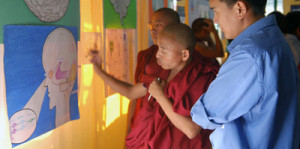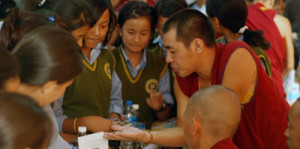In 2009, the Library of Tibetan Works and Archives (LTWA) was honored to organize the 1st Science Exhibition by Monastics as part of a year-long commemoration of the 50th anniversary of the Tibetan peoples’ uprising and the arrival of the Tibetan people and establishment of the Tibetan government in exile. The interactive exhibition focuses on topics of common interest to both Buddhism and science.
How do we remember what we saw yesterday?

Presented by David’s Chronons at Sera Monastery
We present a brief introduction to the brain, showing how different regions of the brain are responsible for various functions, such as vision, auditory, speech, hearing, emotion, and behavior. We focus our presentation on the visual system, and describe vision through the workings of the eye, to the region of the brain responsible for memory. From a Buddhist perspective, there are five direct sense perceptions, one of which is the eye consciousness that functions through the eye organ. From a Buddhist viewpoint, the eye consciousness depends on three factors, (1) an external physical object, (2) an internal sense organ, and (3) an immediately preceding mental consciousness that allows for the perception. We present both the scientific and Buddhist perspective to describe vision and memory.
How is sound made and heard?

Presented by Nargajuna’s Modern Science Group at Drepung Monastery
We combine both Buddhist and scientific understandings to describe the chain of events from the production of sound to our experience of sound. We present the philosophical distinctions regarding the variety of sources of sound from a Buddhist perspective as well as the mental effect of the sound itself. According to Buddhist philosophy, even if a sound enters our ear, without being perceived by a mental consciousness, we will not hear it. We found that the scientific understanding is in good agreement with Buddhist texts, particularly the Abhidharmakosha (Treasury of Knowledge). However, the scientific understanding describes in great detail the process between the production of sound to the workings of the ear. We describe the scientific understanding of sound, starting with sound as a vibration and how sound travels as a wave. We also show the physiology of hearing from the outer ear that contacts the sound wave at the eardrum, to the hair cells in the inner ear that transforms the mechanical wave to a chemical signal sent to the brain.
How was our universe formed?

Presented by Monk Science Corner at Drepung Monastery
We describe the history of our universe according to Buddhist philosophy and modern cosmology. From the scientific viewpoint this universe started from the rapid expansion of a quantum fluctuation, through a process that has been termed “the big bang”. The rapid expansion of the universe and effects of gravity, eventually led to the formation of our solar system, and our home here on earth, the third planet from the sun. According to Buddhist philosophy, individual universes can begin and end, but overall these universes are without a beginning or an end. The Kalachakra text challenges the prevailing assumption among many cosmologists that our big bang was the first of its kind. However, within cosmology, there are less established scientific theories of the multi-verse (multiple universes) that agree well with the Kalachakra texts. The Kalachakra text describes similar origins for a universe, from space-particles. Interestingly, the concept of space-particles have also been suggested by theoretical physicists.
What is light and where does color come from?

Presented by monks from Zhang-Zhung Group at Menri Monastery
We describe the nature and property of light from both the scientific and Bon traditions. Our activities demonstrate how the colors of the visible spectrum can be derived from white light through a prism, and how individual colors can be mixed to form white light. We also describe the difference between mixing light and pigment (paints), and how rainbows are formed through the diffraction and reflection of sunlight through raindrops. According to the Dzogchen and tantric text within the Bon tradition, all materials come from the five elements, and the five elements all come from light. We present a debate concerning the color black, although it is not part of the visible spectrum, from a Buddhist philosophical viewpoint, it is indeed a color.
What are the elements?

Presented by Sakya Pandita Group at Sakya Dhongag Choeling Monastery
This exhibit was inspired by the periodic table of elements and was driven by the interest to generate a table of the Buddhist elements, which include the psycho-physical elements and compositional factors. The Buddhist elements, according to the Abhidharmasamuchaya, are divided into five categories/aggregates, of which there are 25 forms, 12 feelings, 12 recognitions, 8 consciousnesses, and 2 types of compositional factors. After different attempts to organize the table, first in the shape of a mandala and later in the shape of a stupa, a shape resembling the periodic table of elements was created. The exhibit compares and contrasts the Buddhist table of the elements to the scientific table. From the Buddhist viewpoint all the elements can be reduced to subtle consciousness, whereas from the scientific viewpoint all the elements are reduced to quantum particles.
Why do we look the way we do?

Presented by monks from Gaden Science Leadership Group at Gaden Monastery
We describe how physical traits are passed from one generation to the next, from both the perspective of modern genetics and Buddhist philosophy. According to Buddhism there are five aggregates: (1) form, (2) feeling, (3) recognition, (4) compositional factors, and (5) consciousness. It is the form aggregate that determines why we look the way we do. From the Buddhist perspective there are substantial causes that generate similar features as well as substantial causes that do not necessarily generate similar features. This description has strong similarities to the understanding of dominant and recessive genes as described by modern genetics. We show how the contribution of chromosomes from the mother and father can lead to a dominant trait, such as eye color, that is found in the first generation. We also show how a trait can skip a generation, and lead to a trait that is found only in a second generation.
Tour
Drepung Loseling
December 11 to 12, 2009
2-day showing for monastics and local students.
View slideshow of Drepung
Central Tibetan Administration, Dharamsala (Opening)
June 22 to 24, 2009
The 3 day opening for staff and monks and lay students from nearby schools.
View slideshow of Dharamsala

